Hair Replacement Systems Guide
Types of Hair Replacement Systems
- Toupees are small hairpieces that cover the crown and top of the head, where men lose hair most frequently. They are traditionally worn by men. After being custom-fitted and matched to the wearer’s hair or style, they look natural and blend in. Toupees are secured with clips, tape, or glue for daily wear.
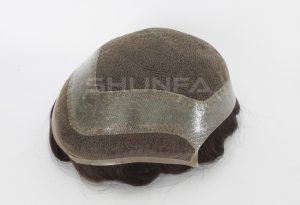
- Wigs cover the scalp and are available for men and women. They are available in many styles, colours, lengths, and materials, including human hair and synthetic fibres. Wigs are popular for people who have lost all their hair or want to change their hairstyle without cutting their hair. Modern wigs are comfortable and realistic, with lace fronts and monofilament bases that match hair growth.

- Hair toppers, also called wiglets or top pieces, are for partial hair loss. They add volume and coverage to problem areas like the crown, parting, and temples. Toppers boost confidence without a wig for women with thinning hair. These clips blend seamlessly with the wearer’s hair for a subtle enhancement.
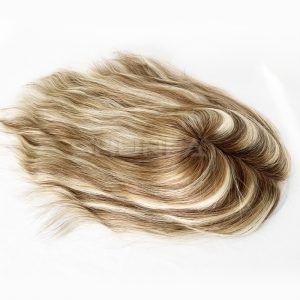
- Hair systems, also known as hair replacement systems, are custom-made pieces designed to cover larger areas of hair loss. These systems match the wearer’s scalp, hair colour, texture, and density for a realistic, semi-permanent solution that can be bonded for weeks.
- Integration systems pull the wearer’s hair through a mesh base and blend it with the hairpiece to create a fuller look. Since the individual’s hair is key to the look, this method provides volume and coverage while looking natural.
How to choose the material for the hair repalcement systems?
Choosing between human hair and synthetic fibres is crucial when choosing a hair replacement system. Both options have pros and cons depending on appearance, maintenance, durability, and cost. Understanding these differences can help you choose based on your lifestyle, budget, and aesthetic preferences.
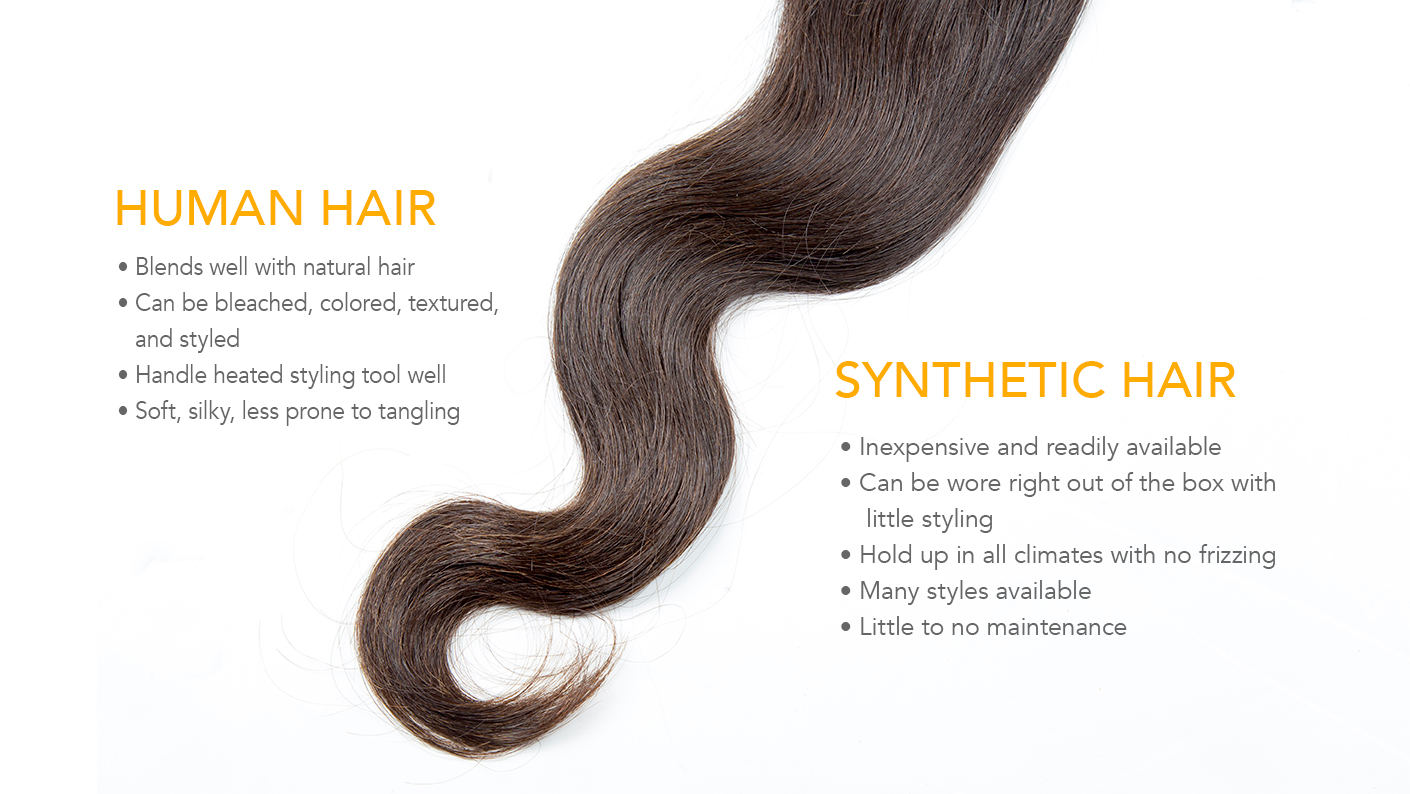
Human Hair:
Pros: – Natural Appearance: Human hair provides a most natural appearance and feel. Like your hair, it moves freely and can be styled.
Versatility: Heat tools can be used to cut, colour, and style it, giving you more control over your appearance.
Variety of texture: The variety of textures in human hair makes it easier to match your natural hair.
Cons: – Maintenance: – Needs regular shampooing, conditioning, and styling, similar to natural hair.
Due to its natural and versatile qualities, it costs more upfront than synthetic options.
Human hair lasts longer than synthetic fibres when properly cared for, but heat and chemicals can degrade it.
Synthetic fibres:
The pros of synthetic wigs and hairpieces include ease of care and less maintenance. Many pre-styled items retain their shape after washing.
Less expensive than human hair, making it more affordable for many.
Colour Retention: Synthetic fibres don’t fade after washing.
The downsides include styling limitations. Use of heat styling tools is limited by synthetic fibre damage. Heat-friendly synthetic hair may not be as versatile as human hair.
Less Natural: Good synthetic hair looks natural, but it lacks texture and movement.
– Durability: The average lifespan of synthetic hair is 4-6 months with daily use, as it can become frizzy or lose shape.
Based on Lifestyle, Budget, and Aesthetics:
– Lifestyle: Consider your hair maintenance time commitment. Synthetic may be best for low-maintenance. Human hair suits those who like to style and change their look.
The budget: If price is a concern, synthetic hair is an option. Due to its durability and versatility, human hair may be cheaper over time.
Human hair offers the most natural look and style customisation. Synthetic hair has a realistic appearance and is improving.
How to choose the suitalbe size for the hair repalcement systems?
- Scalp Measurement: Finding a perfect hairpiece requires accurate measurements. Measure the hairpiece’s placement with a cloth tape. Measure hair loss area length and width for toupees and toppers. To fit wigs, measure your head from the front hairline, behind your ear, to the nape of your neck, and back. Sizing accuracy is improved by measuring ear to ear over the top of your head and forehead to nape.
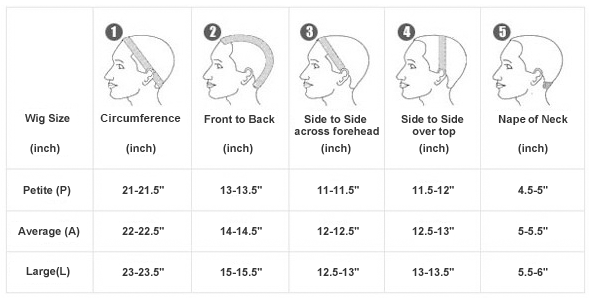
- Base Type Selection: The base material affects hairpiece fit and feel. Lace, monofilament, silicone, and skin-like polymers are options. Silicone and polymer bases grip the scalp, while lace and monofilament bases provide breathability and a more natural appearance.
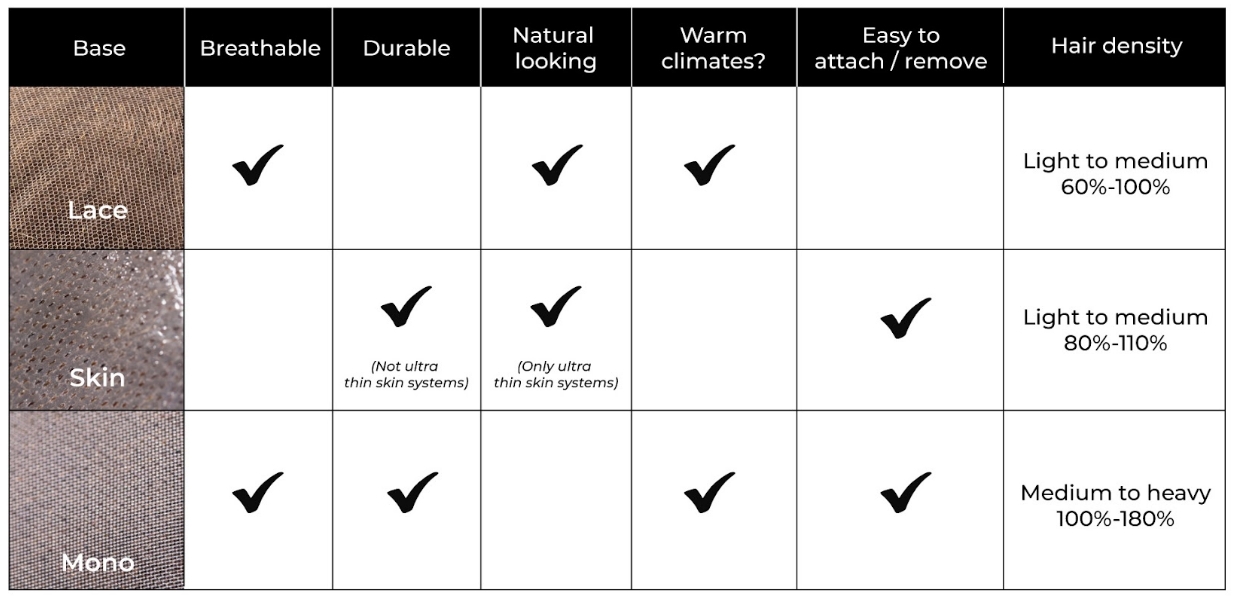
- Size Selection: Small, average, and large hair replacement systems exist. To find the best fit, compare your measurements to the manufacturer’s sizing chart. Many systems can be adjusted for a tighter fit, so choose the larger size for comfort if your measurements are between sizes.
- Consider Customisation: Consider custom hairpieces for those who can’t find the right fit or want something tailored. Although more expensive, custom pieces are made to your exact measurements and specifications for a perfect fit and natural appearance.
- Adjustment Features: To get a better fit, choose toupees, wigs, or toppers with straps or clips. These adjustments can accommodate slight head size or shape changes.
How to choose the base?
When selecting a base for men’s hair toupees, understanding the unique attributes and advantages of each option ensures an informed decision tailored to individual needs. Here’s a professional comparison of the various bases available:
Skin Base
Advantages:
Offers a highly realistic appearance with a seamless, “second skin” look. It’s perfect for creating an undetectable hairline and is easy to attach and clean.
Conditions for Choice: Best for those prioritizing a natural look and feel, and who require low to medium-density hair.
Lace Base
Advantages:
Renowned for its breathability and lightness, providing a comfortable fit for everyday wear. The lace material allows for a versatile styling and natural hairline.
Conditions for Choice:
Ideal for active individuals seeking comfort and natural appearance, suitable for all densities.
Lace With Poly
Advantages:
Combines the breathability of lace with the durability and ease of maintenance of polyurethane (poly) perimeters. This blend offers a good balance between natural appearance and longevity.
Conditions for Choice:
For those who desire the natural look of lace but require enhanced durability and easier attachment.
Mono Base
Advantages:
Known for its strength and durability, mono bases can support higher density hair. They provide a good blend of durability and a fairly natural appearance.
Conditions for Choice:
Recommended for men who need a more robust option due to lifestyle or who prefer a fuller hair look.
Fine Welded Mono
Advantages:
Offers a compromise between the fine appearance of traditional mono and enhanced durability. It’s slightly more breathable than standard mono and supports a variety of hair densities.
Conditions for Choice: Suitable for those seeking a balance between durability and a relatively natural appearance, especially for medium to high-density hair.
Silicon Base
Advantages:
Provides a secure grip to the scalp without additional adhesives, ideal for those with sensitive skin or allergies. It’s waterproof and offers a very realistic appearance.
Conditions for Choice: Perfect for individuals with active lifestyles or those prone to sweating. Great for sensitive scalps.
Injection Lace
Advantages: Features hair injected directly into the lace, creating an appearance of hair growing from the scalp. Offers an extremely natural look with versatile styling options.
Conditions for Choice: Best for men prioritizing a highly authentic look and who prefer light to medium-density hair.
Fishnet
Advantages:Highly breathable and lightweight, making it comfortable for all-day wear. It allows for easy access to the scalp, which can be beneficial for those with partial hair loss wishing to blend toupee hair with their own.
Conditions for Choice: Ideal for those in warmer climates or with an active lifestyle needing maximum scalp breathability.
Integration Base
Advantages:Designed to allow the wearer’s existing hair to be pulled through and blended with the toupee hair, enhancing the natural look and feel. Adjustable and versatile for varying degrees of hair loss.
Conditions for Choice: Perfect for men looking to add volume to thinning hair while maintaining and incorporating their natural hair into the style.
Each of these bases offers distinct advantages tailored to different needs, preferences, and lifestyles. Understanding these nuances ensures a choice that not only enhances appearance but also fits comfortably into one’s daily life, contributing to overall satisfaction and confidence.
How to choose the hair density?
When selecting the density for men’s hair toupees, it’s essential to consider how the amount of hair per square inch affects appearance, comfort, and naturalness. Here’s a detailed comparison of different densities and their corresponding advantages, along with recommendations on who should consider each density.
Light Density
Advantages:
Provides the most natural look for those with naturally thin hair or those who prefer a more subtle enhancement. It’s particularly flattering for older individuals, offering a realistic hair volume that corresponds with aging.
Conditions for Choice:
Ideal for men who have fine hair, are experiencing minimal hair loss, or aim for an age-appropriate look with a high degree of naturalness.
Light to Medium
Advantages:
Strikes a balance between subtlety and coverage, offering a slight volume increase without appearing overly dense. This density can mimic the natural progression from a lighter to a somewhat fuller head of hair.
Conditions for Choice:
Best for men in the early stages of thinning who desire a bit more fullness while maintaining a believable hair density.
Medium Density
Advantages: The standard choice that suits the majority, providing a convincing fullness that covers well without looking unnatural. It offers flexibility in styling and a healthy, youthful appearance.
Conditions for Choice: Suitable for most men, especially those with moderate hair loss seeking a significant yet realistic improvement in hair volume.
Medium to Heavy
Advantages: Adds considerable volume and coverage, creating a more dramatic transformation. This density is durable and excellent for styling versatility, allowing for more pronounced hairstyles.
Conditions for Choice: Recommended for men with substantial hair loss who wish to achieve a fuller look or those who naturally have dense hair and want to match their original hair density closely.
Heavy Density
Advantages: Offers maximum coverage and volume, ensuring no scalp visibility even up close. It’s durable and provides a bold statement, supporting intricate and voluminous hairstyles.
Conditions for Choice: Best for individuals seeking a very full head of hair or those used to having dense hair before experiencing hair loss. Also, suitable for theatrical or film purposes where exaggerated hair volume may be required.
Selecting the right density is crucial for achieving the desired aesthetic and ensuring the toupee integrates seamlessly with any existing hair. Consideration of one’s natural hair density, extent of hair loss, lifestyle, and personal preference will guide the selection process towards the ideal solution.
How to choose the hair type?
Men’s hair toupee hair types should match the wearer’s natural hair, lifestyle, and aesthetic goals. Understanding the benefits and traits of each hair type will help you choose a natural-looking style that enhances your appearance.
The benefits of Indian Remy hair include its versatility and natural luster. Cuticles are kept intact and aligned in one direction to reduce tangling and maintain hair smoothness. It’s lightweight and easy to style to match different textures, making it popular.
Excellent for those seeking quality and affordability. It suits straight, wavy, and lightly curled hair, making it versatile for most wearers.
Chinese virgin hair is known for its strength, thickness, and sleek, straight appearance. Natural straightness and less frizzing keep it in shape longer. This hair can handle harsh styling and treatments.
Choice Conditions:Best for those who need a stronger hairpiece that can withstand styling and environmental factors. It’s ideal for straight, sleek hair.
Designed to match the unique texture of African or Caribbean hair, this hair toupee offers a realistic and authentic appearance for those with natural afro-textured hair. Permed hair mimics natural hair patterns with tighter or looser curls of your choice.
Choice Conditions: For African or Caribbean people or those with naturally tight curls who want to match their hair texture for a seamless blend.
Different hair types offer different benefits for different needs and preferences. Indian Remy hair is versatile and easy to style for a variety of hair textures.
Chinese virgin hair is durable and ideal for long-lasting straight hair. In contrast,
Afro & Permed hair toupees are ideal for afro-textured hair and ensure a natural look.
Selecting the right hair type enhances the hairpiece’s natural appearance and the wearer’s confidence and comfort. Men’s hair toupee hair type should take into account natural hair texture, desired hairstyle, and maintenance.
Full cap VS standard
With men’s hair toupees, choosing the right size—between a full cap and a standard size—is essential for comfort and naturalness. Below are the benefits and best conditions for each size.
Advantages of a full cap toupee include complete coverage for those with complete scalp hair loss. It provides a uniform look that can benefit alopecia totalis and medically treated hair loss patients. Full cap toupees blend into the head’s natural hairline. They also offer more styling options due to more hair.
Choice: Ideal for men with complete hair loss seeking a complete transformation. This option is also good for those who want to change their hairstyle or style it freely.
Toupees in standard size are ideal for covering the crown or top of the head, where male pattern baldness is most common. These toupees are lighter and more comfortable than full caps for daily wear. Men with a lot of natural hair who want to add volume or cover bald spots should consider them because they blend seamlessly with the existing hair.
Conditions for Choice: Best for men with partial hair loss who want to blend the toupee with their remaining hair. It’s also a practical option for those who want greater aesthetic improvement with less maintenance.
Hair loss, coverage, and lifestyle determine whether to wear a full cap or a standard toupee.
Full cap toupees provide complete coverage and the ability to customize hairstyles for those with extensive hair loss. Standard size toupees, on the other hand, target localized hair thinning or balding with a natural-looking enhancement that blends with existing hair.
Hair replacement systems FAQs
Hair replacement systems are non-surgical solutions designed to cover areas of hair loss or thinning. They include wigs, toupees, and toppers, made from human hair, synthetic fibers, or a blend of both, offering a natural-looking appearance and restoring confidence.
The choice depends on your lifestyle, budget, and preference for maintenance. Human hair offers a more natural look and styling versatility but requires more care and is pricier. Synthetic hair is cost-effective, low maintenance, and retains its style longer but offers less styling flexibility.
Yes, with advancements in technology and craftsmanship, hair replacement systems can look incredibly natural. Choosing the right color, density, and texture, along with professional customization and fitting, ensures that your hairpiece blends seamlessly with your existing hair.
The lifespan varies based on the material, maintenance, and frequency of wear. Typically, human hair systems last 6-12 months, while high-quality synthetic systems can last 4-6 months with proper care.
Yes, but it depends on the type of attachment used. Some systems offer waterproof adhesives or secure clips that allow for swimming and vigorous activities. However, frequent exposure to chlorine and sweat may require more frequent maintenance.
For human hair, use sulfate-free shampoos and conditioners, and avoid high heat when styling. For synthetic hair, use products specifically designed for synthetic fibers. Regular cleaning, conditioning, and proper storage will extend the life of your hairpiece.
It’s possible, especially with certain secure attachment methods, but it’s not recommended as it can shorten the lifespan of the hairpiece due to tangling and matting. Removing and properly storing your hairpiece at night is advisable.
